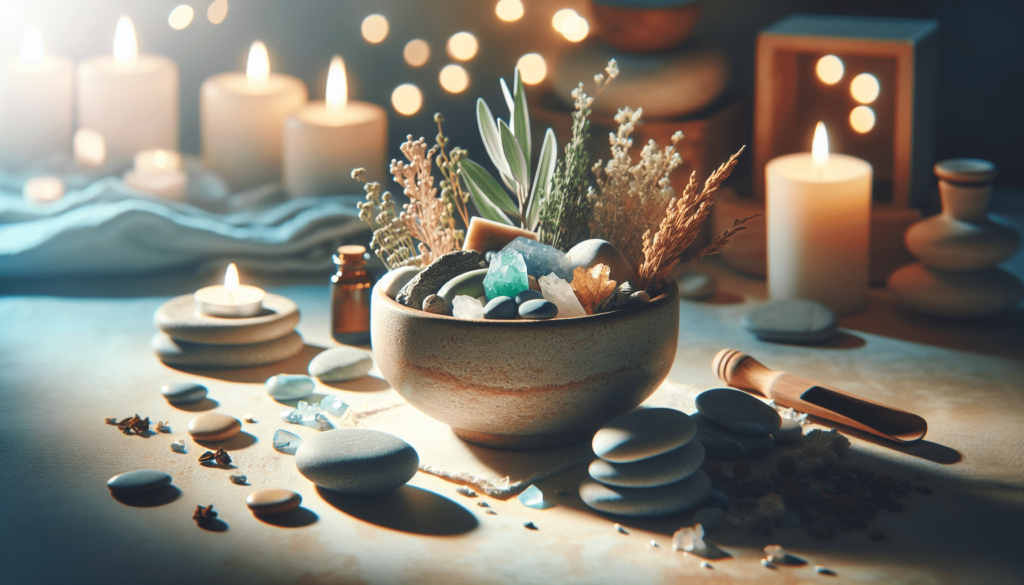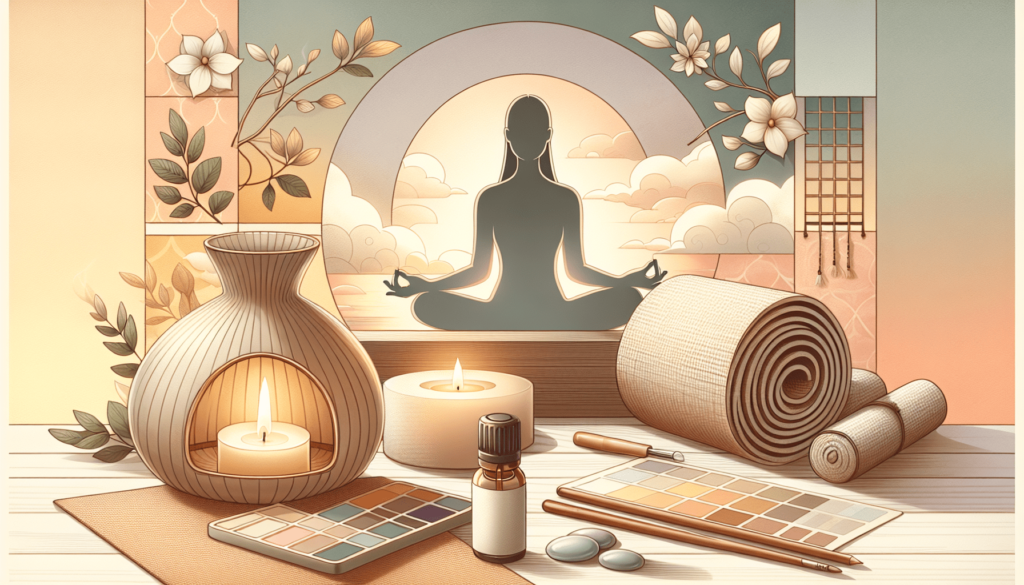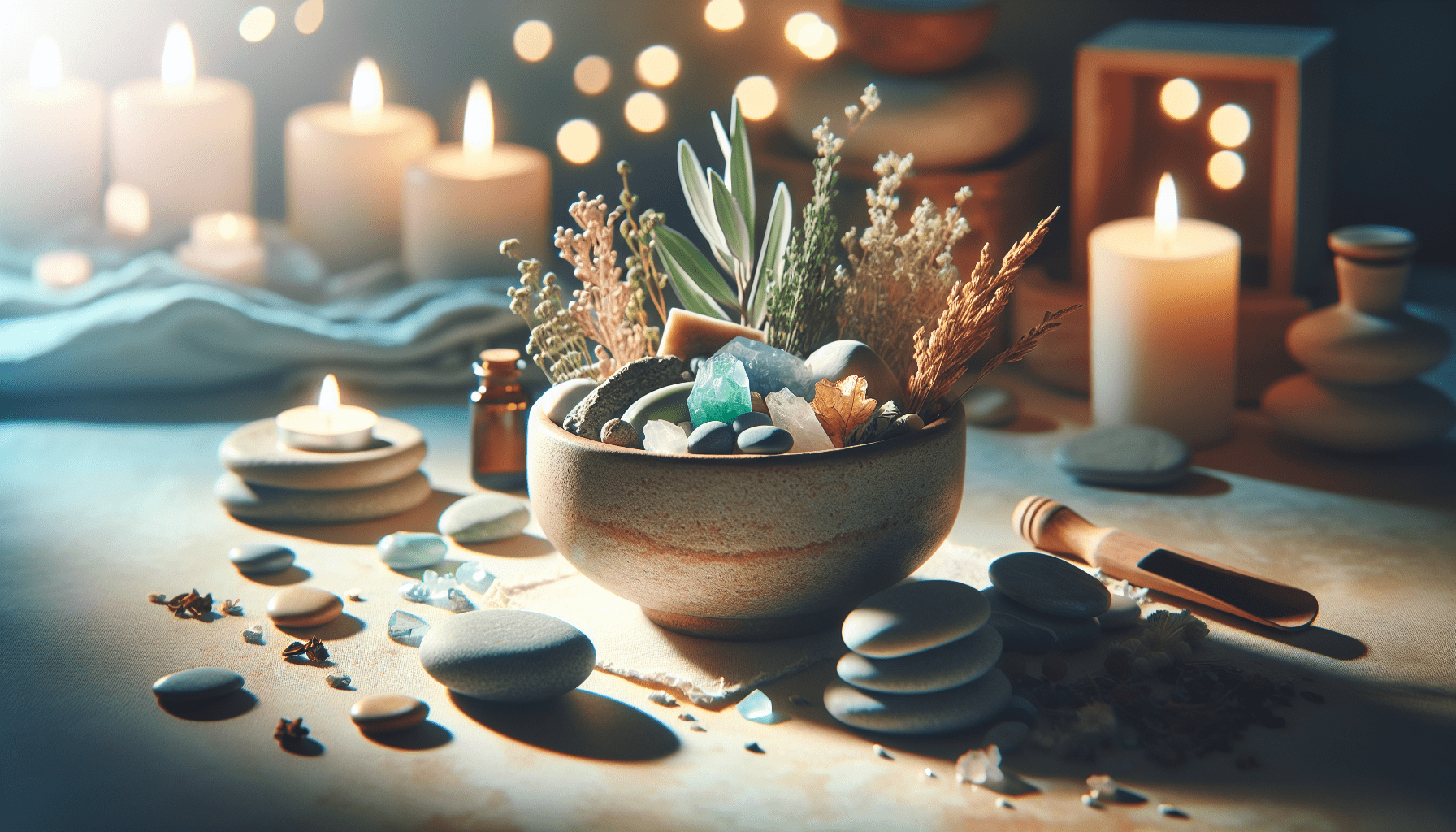If you’re seeking a comprehensive approach to self-care, look no further. “A Guide to Holistic Self-Care Rituals” provides a treasure trove of practices that cater to your mind, body, and spirit. From meditation and breathwork to nourishing foods and physical exercises, this article offers a roadmap to cultivating a balanced and harmonious lifestyle. Join us as we explore the transformative power of holistic self-care rituals that will leave you feeling refreshed, rejuvenated, and ready to take on the world.

1. Meditation and Mindfulness
1.1 Benefits of Meditation
Meditation has numerous benefits for your overall well-being. It can reduce stress, improve focus and concentration, increase self-awareness, promote emotional stability, and enhance mental clarity. Engaging in regular meditation practice can also lead to a greater sense of inner peace, improved sleep quality, and a heightened ability to manage anxiety and negative emotions.
1.2 Types of Meditation Techniques
There are several different types of meditation techniques, each with its own unique approach and focus. Some popular meditation techniques include:
-
Mindfulness meditation: This technique involves focusing on the present moment, paying attention to sensations, thoughts, and emotions without judgment.
-
Loving-kindness meditation: This practice involves cultivating feelings of compassion, love, and goodwill towards oneself and others.
-
Transcendental meditation: This technique involves silently repeating a mantra, which helps achieve a state of deep relaxation and inner peace.
-
Guided meditation: In guided meditation, an instructor or audio recording provides verbal guidance to help you relax and focus your mind.
1.3 How to Practice Mindfulness
Mindfulness is the practice of being fully present and engaged in the present moment, without judgment. Here are some steps to practice mindfulness:
- Find a quiet and comfortable space where you won’t be disturbed.
- Sit in a relaxed position, either on a cushion or a chair.
- Close your eyes and take a few deep breaths to center yourself.
- Begin by focusing on your breath, paying attention to the sensation of each inhalation and exhalation.
- As thoughts or distractions arise, gently acknowledge them and then return your focus to your breath.
- Gradually expand your awareness to include the sensations in your body, the sounds around you, and any thoughts or emotions that arise.
- Practice non-judgmental awareness and acceptance of whatever arises in the present moment.
2. Yoga and Stretching
2.1 Benefits of Yoga
Yoga is a holistic practice that combines physical postures, breathing exercises, and meditation to promote overall health and well-being. Some benefits of practicing yoga include increased flexibility, improved strength and balance, reduced stress and anxiety, enhanced body awareness, and improved mental clarity.
2.2 Different Types of Yoga
There are various types of yoga, each with its own focus and approach. Here are a few popular types of yoga:
-
Hatha yoga: This is a gentle and basic form of yoga that focuses on physical postures and breathing techniques.
-
Vinyasa yoga: This style of yoga is more dynamic and involves flowing sequences of movements synchronized with the breath.
-
Ashtanga yoga: Ashtanga yoga is a physically demanding practice that follows a specific sequence of postures, emphasizing strength and flexibility.
-
Restorative yoga: Restorative yoga is a gentle and relaxing practice that uses props to support the body in passive poses, allowing for deep relaxation and restoration.
2.3 Basic Stretching Exercises
Stretching is an important component of self-care and can help improve flexibility, prevent injuries, and relieve muscle tension. Here are some basic stretching exercises you can incorporate into your self-care routine:
- Neck stretches: Gently tilt your head to one side, bringing your ear towards your shoulder. Hold for a few seconds and then repeat on the other side.
- Shoulder rolls: Roll your shoulders forward in a circular motion, and then roll them backward.
- Chest stretch: Interlace your fingers behind your back and gently lift your arms, feeling a stretch in your chest and shoulders.
- Hamstring stretch: Sit on the floor with one leg extended and the other bent. Reach towards your extended leg, feeling a stretch in the back of your thigh. Swap legs and repeat.
- Quad stretch: Stand upright and hold onto a stable object. Bend one knee and reach back to grab your ankle, pulling your heel towards your glutes. Repeat with the other leg.
3. Journaling and Self-Reflection
3.1 Importance of Journaling
Journaling is a powerful tool for self-reflection and self-care. It allows you to explore your thoughts, emotions, and experiences, providing a safe space for self-expression and self-discovery. Regular journaling can help enhance self-awareness, improve mood and emotional well-being, reduce stress, and clarify thoughts and feelings.
3.2 Different Types of Journaling
There are various types of journaling techniques that you can explore based on your preferences and goals. Some popular types of journaling include:
-
Gratitude journaling: This involves writing down three things you are grateful for each day, cultivating a positive mindset and focusing on the good in your life.
-
Free-writing: Free-writing is a stream-of-consciousness writing exercise where you write continuously for a certain period of time without judgment or editing.
-
Emotional journaling: Emotional journaling involves expressing and processing your emotions through writing, allowing you to gain insights into yourself and your experiences.
-
Goal-setting journaling: This type of journaling focuses on setting and tracking goals, breaking them down into actionable steps, and reflecting on progress.
3.3 Prompts for Self-Reflection
If you’re not sure where to start with self-reflection, here are some prompts to get you started:
- What are three things that bring you joy?
- What is one challenge you’ve overcome recently, and what did you learn from it?
- What are your core values, and how do they align with your actions and decisions?
- What is one limiting belief you have about yourself, and how can you challenge and reframe it?
- What are your top priorities in life, and how can you align your actions with these priorities?

4. Aromatherapy and Essential Oils
4.1 Benefits of Aromatherapy
Aromatherapy is the use of essential oils for therapeutic purposes, promoting physical, emotional, and mental well-being. Some benefits of aromatherapy include stress relief, improved mood, relaxation, enhanced sleep quality, and alleviation of headaches and migraines.
4.2 Popular Essential Oils and Their Uses
There are numerous essential oils available, each with its own unique properties and uses. Here are some popular essential oils and their common uses:
-
Lavender: Lavender is well-known for its calming and relaxing effects. It can help reduce stress and promote restful sleep.
-
Peppermint: Peppermint has invigorating and refreshing properties. It can help improve focus and mental clarity, relieve headaches, and soothe muscle aches.
-
Lemon: Lemon essential oil has energizing and uplifting properties. It can help improve mood, increase concentration, and provide a fresh scent.
-
Eucalyptus: Eucalyptus oil is commonly used for respiratory issues. It can help relieve congestion, clear the sinuses, and support respiratory health.
4.3 How to Use Essential Oils Safely
When using essential oils, it’s important to ensure safety and proper dilution. Here are some guidelines for using essential oils safely:
-
Dilution: Most essential oils should be diluted with a carrier oil, such as jojoba oil or coconut oil, before applying to the skin. The recommended dilution ratio is typically 1-2% (5-10 drops of essential oil per 1 ounce of carrier oil).
-
Patch test: Before using a new essential oil, perform a patch test on a small area of skin to check for any allergic reactions or sensitivities.
-
Avoid ingestion: While some essential oils can be taken internally under the guidance of a qualified professional, it’s generally safest to avoid ingesting essential oils.
-
Consult a professional: If you have any specific health concerns, are pregnant or breastfeeding, or are taking medications, it’s important to consult with a qualified aromatherapist or healthcare professional before using essential oils.
5. Creative Expression through Art or Writing
5.1 Art Therapy and its Benefits
Art therapy is a form of creative expression that can promote self-discovery, healing, and personal growth. Engaging in art or writing as a form of self-care can have several benefits, including stress reduction, improved mood, enhanced self-esteem, and increased self-awareness.
5.2 Different Types of Creative Expression
There are many different ways to engage in creative expression as part of your self-care routine. Here are some examples:
-
Visual art: Painting, drawing, coloring, or collage-making can be highly therapeutic and allow for self-expression and exploration.
-
Writing: Journaling, poetry, or free-writing exercises can help process emotions, gain insights, and explore creativity.
-
Music: Playing an instrument, singing, or listening to music can have a calming and uplifting effect on your mood.
-
Dance or movement: Engaging in dance or movement-based activities can help release tension, improve body awareness, and promote self-expression.
5.3 How to Incorporate Art or Writing into Self-Care
Incorporating art or writing into your self-care routine doesn’t have to be complicated or time-consuming. Here are some simple ways to get started:
- Set aside a designated time each day or week for creative expression.
- Create a small art or writing space in your home where you can feel inspired and comfortable.
- Experiment with different art supplies, writing prompts, or creative techniques to keep things interesting.
- Allow yourself to explore and create without judgment or pressure to produce a certain outcome.
- Consider joining a creative group or class to connect with others who share similar interests.
6. Digital Detox and Unplugging
6.1 Importance of Disconnecting from Technology
In today’s technologically connected world, it’s important to prioritize intentional time away from screens and digital devices. Engaging in a digital detox and unplugging from technology can help reduce stress, improve sleep, enhance productivity and focus, and promote a healthier relationship with technology.
6.2 Tips for a Successful Digital Detox
Here are some tips to help you have a successful digital detox:
-
Set clear boundaries: Establish specific times or days when you will disconnect from technology completely.
-
Create a technology-free space: Designate areas in your home where you can fully disconnect, such as a reading nook or a relaxation corner without any screens.
-
Find alternative activities: Plan activities that don’t involve screens, such as going for a walk, practicing yoga, reading a physical book, or spending time with loved ones.
-
Utilize apps and tools: There are various apps and tools available that can help you limit your screen time and set reminders for regular breaks.
6.3 Creating Healthy Boundaries with Screens
Establishing healthy boundaries with screens and technology is crucial for maintaining balance and well-being. Here are some strategies to create healthier habits:
-
Set screen-free times: Designate specific times each day or week where you commit to be screen-free, allowing yourself to focus on other activities or relaxation.
-
Create a bedtime routine: Avoid using screens for at least an hour before bedtime to promote better sleep quality and relaxation.
-
Turn off notifications: Minimize distractions by turning off non-essential notifications on your devices, allowing you to focus on the present moment.
-
Practice mindful screen usage: Before engaging with screens, pause and ask yourself if it aligns with your intentions and values. Be mindful of how much time you spend on screens and the impact it has on your well-being.
7. Nourishing Nutrition and Hydration
7.1 Importance of Nourishing Foods
Proper nutrition is an essential aspect of self-care. Consuming nourishing foods can provide your body with the nutrients it needs to function optimally, boost energy levels, support a healthy immune system, and promote overall wellness. Eating a balanced diet that includes a variety of fruits, vegetables, whole grains, lean proteins, and healthy fats is key to nourishing your body.
7.2 Nutrient-Dense Meal Ideas
Here are some nutrient-dense meal ideas to incorporate into your self-care routine:
- Breakfast: A bowl of oatmeal topped with fresh berries, nuts, and a drizzle of honey.
- Lunch: A salad with mixed greens, grilled chicken, cherry tomatoes, cucumbers, avocado, and a homemade vinaigrette.
- Dinner: Baked salmon with roasted vegetables and quinoa.
- Snacks: Greek yogurt with a sprinkle of granola and sliced bananas, or carrot sticks with hummus.
7.3 Hydration and its Impact on Self-Care
Staying hydrated is crucial for overall health and well-being. Drinking enough water throughout the day helps maintain proper bodily functions, supports digestion, regulates body temperature, and promotes healthy skin. Aim to drink at least 8 cups (64 ounces) of water per day, and consider incorporating herbal teas or infused water for added variety and hydration.
8. Restful Sleep and Relaxation Techniques
8.1 Creating a Sleep Routine
Establishing a sleep routine can help improve the quality and duration of your sleep. Consider these tips for creating a restful sleep routine:
- Set a consistent bedtime and wake-up time, even on weekends.
- Create a relaxing pre-sleep routine, such as reading a book, taking a warm bath, or listening to calming music.
- Keep your bedroom cool, dark, and quiet to promote a sleep-friendly environment.
- Limit exposure to screens and stimulating activities at least an hour before bedtime.
- Avoid consuming caffeine or heavy meals close to bedtime.
8.2 Relaxation Techniques for Better Sleep
Engaging in relaxation techniques before bedtime can help calm your mind and prepare your body for sleep. Here are some relaxation techniques to consider:
- Deep breathing: Practice deep, slow breaths in through your nose, and out through your mouth, focusing on each breath to induce a state of relaxation.
- Progressive muscle relaxation: Start from your toes and progressively tense and release each muscle group in your body, working your way up to your head.
- Guided imagery: Imagine yourself in a peaceful, relaxing place, using your senses to fully immerse yourself in the experience.
- Meditation: Practice a short guided meditation or mindfulness exercise to help quiet your mind and promote relaxation.
8.3 Creating a Relaxing Environment
Creating a relaxing environment can contribute to feelings of peace and relaxation. Consider the following tips:
- Choose calming colors for your bedroom, such as soft blues or neutrals.
- Use soft, cozy bedding and pillows to create a comfortable sleep environment.
- Incorporate soothing scents, such as lavender or chamomile, through aromatherapy or linen sprays.
- Use blackout curtains or an eye mask to block out excess light.
- Consider using a white noise machine or playing calming nature sounds to drown out any disruptive noises.
9. Physical Activity and Outdoor Exposure
9.1 Benefits of Regular Exercise
Regular physical activity has numerous benefits for your physical and mental well-being. Some benefits of exercise include increased energy levels, improved mood, reduced stress and anxiety, enhanced cognitive function, better sleep, and a reduced risk of chronic diseases.
9.2 Different Types of Physical Activity
Engaging in different types of physical activity can help keep your exercise routine exciting and engaging. Here are some examples of physical activities you can incorporate into your self-care routine:
- Cardiovascular exercises: Activities such as jogging, dancing, swimming, or cycling that get your heart rate up and increase endurance.
- Strength training: Using weights, resistance bands, or bodyweight exercises to build strength and tone muscles.
- Yoga or Pilates: These practices incorporate a combination of strength, flexibility, and mindfulness.
- Outdoor activities: Hiking, gardening, or playing a sport outdoors to enjoy the benefits of nature and fresh air.
9.3 Incorporating Outdoor Time into Self-Care
Spending time outdoors can have a positive impact on your well-being. Here are some ways to incorporate outdoor time into your self-care routine:
- Take a walk or jog in a nearby park or nature reserve.
- Plan outdoor picnics or meals to enjoy nature while nourishing your body.
- Practice outdoor yoga or mindfulness exercises.
- Engage in outdoor hobbies such as gardening, birdwatching, or photography.
- Plan outdoor activities with friends or loved ones, such as hiking, biking, or playing sports.
10. Surroundings and Decluttering
10.1 Importance of a Clutter-Free Environment
Your physical surroundings can have a significant impact on your mental and emotional well-being. Living in a clutter-free environment can help reduce stress, improve focus and productivity, promote relaxation, and create a sense of calm and clarity.
10.2 Decluttering Tips and Techniques
If you’re looking to declutter your living space, consider these tips and techniques:
- Start with small manageable areas, such as a drawer or a closet, to build momentum.
- Sort items into categories (keep, donate, discard) to make the decluttering process more organized.
- Be mindful of sentimental items, keeping only those that truly bring you joy or have significant meaning.
- Set aside dedicated time each week or month for decluttering, making it a regular part of your self-care routine.
- Consider seeking guidance from decluttering experts or following popular decluttering methods, such as the KonMari method.
10.3 Environments that Promote Relaxation and Mindfulness
Creating an environment that promotes relaxation and mindfulness can help enhance your self-care practice. Consider the following tips:
- Use soft lighting, such as candles or diffused lamps, to create a cozy and calming atmosphere.
- Incorporate natural elements, such as plants or natural materials, to bring a sense of tranquility and connection to nature.
- Create designated spaces for relaxation and self-care activities, such as a meditation corner or a cozy reading nook.
- Keep your environment organized and clutter-free to promote a sense of calm and reduce distractions.
- Surround yourself with objects, artwork, or photographs that bring you joy and inspire positive emotions.
In conclusion, holistic self-care is about nurturing your mind, body, and spirit. By incorporating various practices such as meditation, yoga, journaling, aromatherapy, creative expression, digital detox, nourishing nutrition, restful sleep, physical activity, and decluttering, you can create a well-rounded self-care routine that supports your overall well-being. Take the time to prioritize yourself and engage in these activities regularly to cultivate a healthier and happier life.

